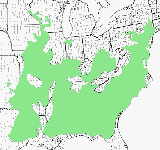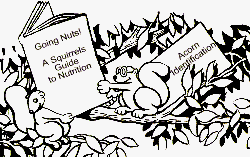


 river birch
river birchBetula nigra
River birch is a medium to large tree with a mature height of 70 feet and spread of 50 feet. This tree is appropriate for most yards, and parks. Often grown as a multi-stem specimen, the specie does best on
moist, well-drained soil but adapts well to a wide range of extreme conditions but needs acidic soil. The leaves are triangular with serrated edges. The male flowers (catkins) add some interest. The bark exfoliates to expose white to bronze bark on younger stems, older stems are deeply furrowed. The cultivars ‘Dura-Heat’ and ‘Heritage’ are preferred for their drought resistance. Watch for the cultivar ‘City Slicker’ with all white bark coming out soon.
 Plant illustration modified from original by Dale Larison, Missouri Department of Conservation
Plant illustration modified from original by Dale Larison, Missouri Department of Conservation
Range map modified from USDA Forest Service Silvics of North America Web site - www.na.fs.fed.us/spfo/
pubs/silvics_manual/Volume_2/
betula/nigra.htm.

|
Joplin MDC Office has Moved!
The Joplin MDC office has moved to the Wildcat Glades Conservation and Audubon Center in Wildcat park. The facility is a joint venture between the City of Joplin, Audubon Society, and MDC. It places my office next to the Wildcat Park Chert Glade, an ecologically unique environment. The facility offers walking trails, educational displays, meeting rooms, and programs by the Audubon Society. I will utilize the meeting rooms for workshops as they are available. The grand opening for the facility is September 8, call Audubon at 417-623-2211 for details. My NEW ADDRESS is 201 W. Riviera Rd., Ste B, Joplin, MO 64804. My phone number and email has stayed the same. You are welcome to visit, but do not expect to see all of the facility until after September 8.
ISA Certification Exam Training Being Offered
ISA Certified arborists have a minimum of three years experience in some aspect of tree care and have passed an exam developed by an international panel of experts. The exam extensively covers every aspect of tree care and the individuals must have an acceptable level of knowledge in all areas of arboriculture.
The Southwest chapter of the Missouri Community Forestry Council is offering two Certified Arborist Training Courses in preparation for an ISA Certification Exam on October 26 (register for this exam on the ISA web site). The training courses cover all of the domains of the exam in one hour increments.
The first course is set up as 6 two hour sessions on September 13, 20, 27 - October 4, 11, 18, 2007 from 6 - 8 PM each night at the MDC Regional Office in Springfield. There is a $30 fee each to cover refreshments. The second course is a two day marathon on October 24 - 25, 2007 from 8 AM - 4:45 PM at the Springfield Nature Center. There is a $10 fee each to cover refreshments.
To register for either course, mail your name, address, phone number, number attending from your organization and a check for the registration fee for each individual. Make your check payable to: MCFC, Missouri Community Forestry Council and mail to: Missouri Department of Conservation, MCFC, Cindy Garner, 2630 North Mayfair, Springfield, MO 65803.
If you have Questions about the training courses, call Cindy Garner at Missouri Department of Conservation at 417-895-6880 Ext. 237.
Training: The Basis of Quality Tree Care

|
One person can know a lot about trees, no one knows everything. The only way to increase your and your staffs knowledge is to attend and conduct training. Training may be simple and off of a tailgate. It may be complex and require days of attending classes. Either way you and your staff gain or refresh knowledge. Our clients (for fee or public service) depend on us to be the best possible in our field of expertise. Training helps us to accomplish this. Take advantage of training opportunities as they come up from reputable sources. Your clients trees will benefit from your knowledge and expertise.
What Is A Hazardous Tree?
It´s a hazard tree! I hear that phrase often, but what really makes a tree hazardous? Some trees have messy fruit. Although annoying, this is not a hazardous condition. A tree may block the view at a street intersection. This creates a unsafe condition, but the tree itself is not hazardous. A tree is deemed hazardous after it has been evaluated. During the evaluation a defect in the roots, trunk, or branches is identified that creates an unacceptable risk of failure of the part and / or tree AND a target is present. A target is something of value that can be damaged or killed if the tree had a failure occur. Common targets of concern are people; cars; and buildings.
You can learn more about hazard tree assessment by attending the Hazard Trees Workshop in Springfield on September 25, 2007. Visit www.arborday.org/treeplanting for more information and to register.